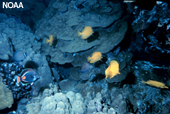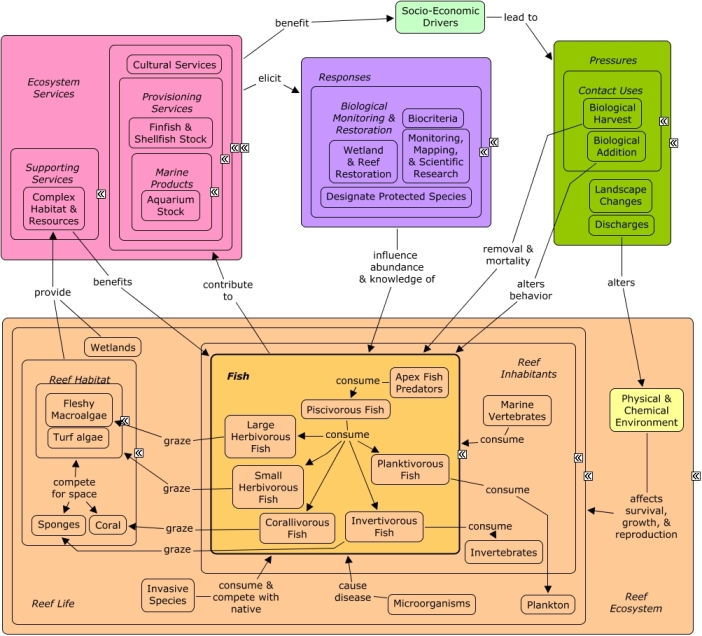ReefLink Database

Small Herbivorous Fish
Small herbivorous fish are small bodied fish species, such as damselfish, tangs, and surgeonfish that primarily feed on algae.
CMap

CMap Description
The fish found on coral reefs are essential for coastal communities and extremely important in the wider world. Small herbivorous fish, such as damselfish, tangs, and surgeonfish, graze turf algae. Many small herbivorous fish species are important as aquarium stock and all species are important to cultural services of coral reefs. Small herbivorous fish are unique in the use of complex habitat & resources provided by the reef; unlike their larger counterparts, small herbivorous fish guard algal patches and will sometimes even cultivate them. Wetlands provide nursery habitat that supports the fish community. Small herbivorous fish provide a valuable link in the trophic food web as they are consumed by piscivorous fish, apex fish predators, and marine mammals and reptiles. Like all fish species, small herbivorous fish are stressed and killed by competing invasive species, disease-causing microorganisms, and disturbances of the physical & chemical environment. Socio-economic drivers lead to the removal & mortality of small herbivorous fish through harvesting pressures and to behavior modifications through supplemental feeding. Biological monitoring, mapping, research, and restoration is paramount to ensure the flow of services from reef fish.Citations
More than 50 citations. Click here to load.
| Citation | Year | Study Location | Study Type | Database Topics |
|---|
Management Options
| Management Option | Description | Sources | Database Topics |
|---|---|---|---|
| Monitor & Research: Fisheries Sampling | Improved fisheries sampling programs require improving the spatial resolution of commercial and recreation fisheries-dependent and fisheries-independent sampling programs to provide statistics on catch and effort. Improved sampling can be achieved through evaluating and enhancing census programs by using smaller sampling areas. Also, fishery pre-recruitment monitoring efforts should be continued for long-term prediction of fishery stocks. Last, investigating life histories of fishery species needs to be conducted because it is currently a gap. | NOAA Marine Sanctuary Program. 2007. Florida Keys National Marine Sanctuary revised management plan. National Ocean Service, Key West, FL. |
Apex Fish Predators; Biological Harvest; Biological Monitoring & Restoration; Biological Monitoring, Mapping, & Scientific Research; Corallivorous Fish; Decision Support; Ecosystem Monitoring & Restoration; Finfish & Shellfish Stock; Fish; Fishing & Harvesting Management; Fishing Sector; Invertivorous Fish; Large Herbivorous Fish; Piscivorous Fish; Planktivorous Fish; Provisioning Services; Reef Inhabitants; Reef Life; Security & Public Administration Policies; Small Herbivorous Fish |
| Monitor & Research: Biological Status and Trends Monitoring | This activity produces long-term comprehensive information on sanctuary-wide status and trends of biological resources. Data that could be collected on coral reef communities includes but is not limited to species abundance and density, biodiversity, benthic cover, coral condition, growth, recruitment, predation, and grazing. Mangroves and seagrasses should also be monitored. With adequate baseline data, changes in community structure and biocriteria can be identified and restoration or protection efforts can be taken. | NOAA Marine Sanctuary Program. 2007. Florida Keys National Marine Sanctuary revised management plan. National Ocean Service, Key West, FL. |
Algae; Anemones & Zooanthids; Apex Fish Predators; Aquaculture; Aquarium Stock; Biochemical & Genetic Resources; Biocriteria; Biological Harvest; Biological Monitoring & Restoration; Biological Monitoring, Mapping, & Scientific Research; Bivalves; Calcareous Macroalgae; Contact Uses; Coral; Coralline Algae; Cyanobacteria; Decision Support; Echinoderms; Ecosystem Monitoring & Restoration; Finfish & Shellfish Stock; Fish; Fishing Sector; Food & Energy Policies; Hydrocoral; Invasive Species; Invertebrates; Large Herbivorous Fish; Lobster, Crab, & Shrimp; Mangroves; Marine Birds; Marine Products; Marine Vertebrates; Marine Worms; Microorganisms; Molluscs; Octocoral; Octopus & Squid; Ornamental Jewelry & Art; Pathogens; Pharmaceuticals & Cosmetics Sources; Physical Damage; Primary Production; Provisioning Services; Resource Use Management; Sea Turtles; Sea Urchins; Seagrasses; Seastars; Skeletal Coral; Small Herbivorous Fish; Snails & Conch; Sponges; Stony Coral; Tunicates; Wetlands; Whales & Dolphins |
| Resource Use Management: Seasonal Fisheries and Harvesting | Finfish and shellfish stocks may be more or less susceptible to fishing pressures during certain times of the year. This may be due to seasonality of recruitment and/or changes in food/predation pressures. If fishing restrictions may be more successful if this seasonality is taken into consideration and fishing pressure adjusted accordingly. | Accidental & Illegal Harvest; Apex Fish Predators; Artisanal Fishing; Biochemical & Genetic Resources; Biological Harvest; Bivalves; Commercial Fisheries; Corallivorous Fish; Decision Support; Echinoderms; Finfish & Shellfish Stock; Finfish Harvest; Fish; Fisheries & Hunting Policies; Fishing & Harvesting Management; Fishing Sector; Food & Energy Policies; Invertebrate Harvest; Invertivorous Fish; Large Herbivorous Fish; Live Collection; Lobster, Crab, & Shrimp; Marine Products; Molluscs; Octopus & Squid; Permitting & Zoning; Piscivorous Fish; Planktivorous Fish; Provisioning Services; Recreational Fishing; Small Herbivorous Fish; Snails & Conch; Sponges; Tourism & Recreation Policies | |
| Restoration: Removal of Invasive Algae | Benthic organisms on reefs maintain a delicate balance competing for space. In many areas, the competition between coral and algae has fallen out of balance due to confounding factors. Factors such as decreased herbivorous fish and invertebrates, and invasive algae species have allowed faster growing algae to take over many reefs, often growing into smothering mats that cover and kill coral. In Hawaii, there has been some success physically removing invasive algae such as Kappaphycus using underwater vacuums extended down from barges or volunteer events in shallower areas. | The Nature Conservancy. 2010.Two Million Pounds of Invasive Algae Removed From Maunalua Bay. (not cited) |
Algae; Aquaculture; Biological Addition; Biological Harvest; Biological Monitoring & Restoration; Biological Monitoring, Mapping, & Scientific Research; Calcareous Macroalgae; Collaboration & Partnering; Coral; Coralline Algae; Decision Support; Ecosystem Monitoring & Restoration; Escape & Release of Non-natives; Fishing & Harvesting Management; Fishing Sector; Fleshy Macroalgae; Hydrocoral; Invasive Species; Large Herbivorous Fish; Octocoral; Reef Habitat; Skeletal Coral; Small Herbivorous Fish; Stony Coral; Turf Algae; Wetland & Reef Restoration; Zooxanthellae |
Laws
| Legal Citation | Purpose of Law | Management Organization | Database Topics |
|---|
